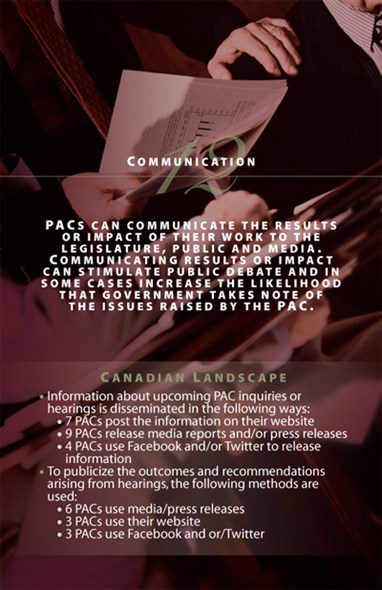Communication

Communication Strategy
PACs can consider ways to improve public awareness about their oversight role and the results of their work.
Practices to Consider
- Establish a communications plan targeting stakeholders, legislators, witnesses, public and the media.
- Direct clerks and researchers to draft non-partisan news releases for the committee.
- Publish all reports, observations and recommendations and make them available on the internet.
- Issue an annual report highlighting results achieved.
- Offer to brief the media about PAC work and results.
Communicating Value-Added in a Non-Partisan Manner
PACs are at the heart of the oversight process. If PAC members can demonstrate their value to their constituents, the members may be even more motivated to fulfill their oversight role.
Practices to Consider
- Create greater awareness of the PAC’s role as an oversight committee and of the value added.
- Relay to the public the results of their work, such as the recommendations they issue and the government’s response to their recommendations.
- Publicize departmental action taken in response to recommendations and observations. Departments and agencies may post their responses on their websites.
- Explain the PAC’s often highly technical work in plain language. This will make it easier for the legislature, public and media to understand the impact of the PAC.
Practice Highlights
- In Quebec, the clerk distributes the PAC’s report and news release to all members of the Assembly and the media on the day a report is tabled.
- The House of Commons PAC sends its reports and news releases to all members of the House of Commons and makes them available on the House website.
- In the Northwest Territories, outcomes of inquiries and recommendations are released through committee reports, news releases, media conferences and sessional radio, television and webcasting.
- The PACs of Quebec, Northwest Territories, Saskatchewan, and Alberta use social media tools (e.g. Twitter or Facebook) as a communications tool.
- PreviousPerformance and Impact
- Background


